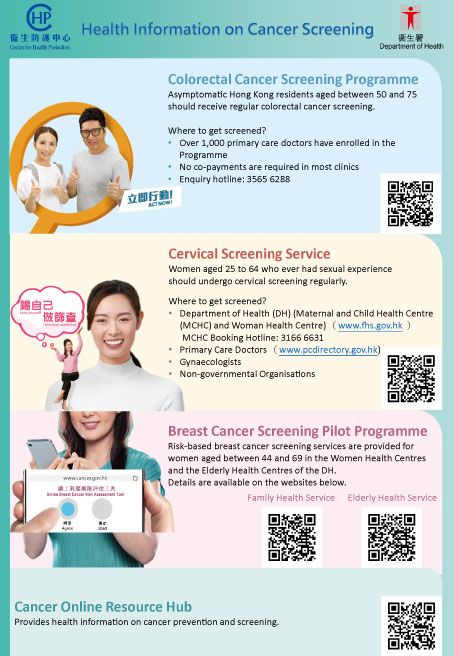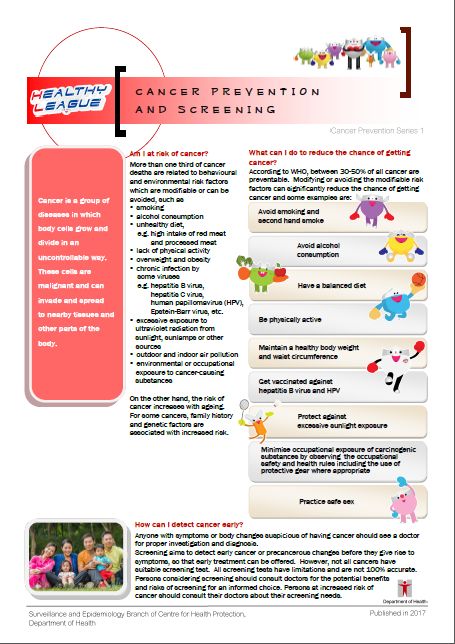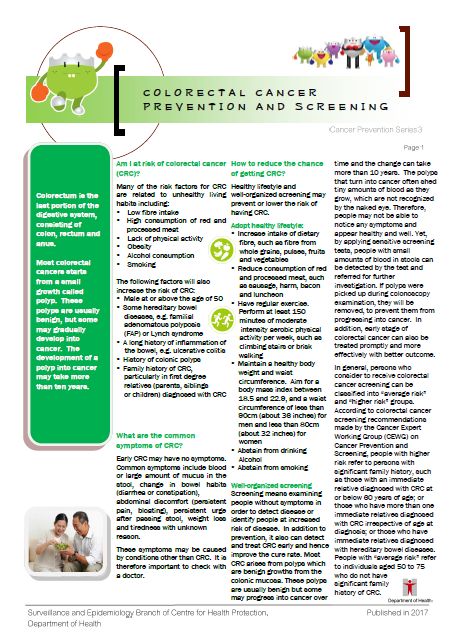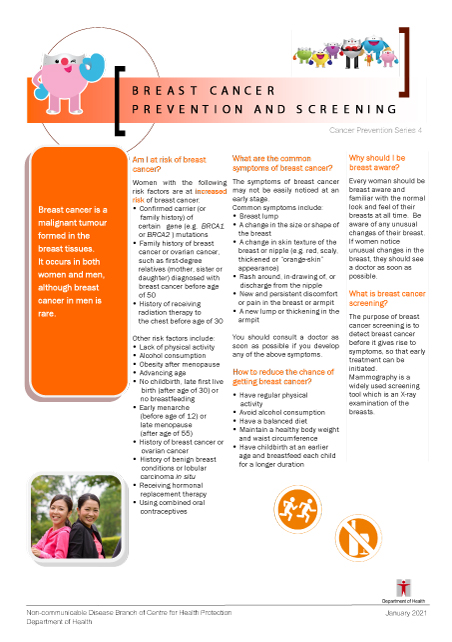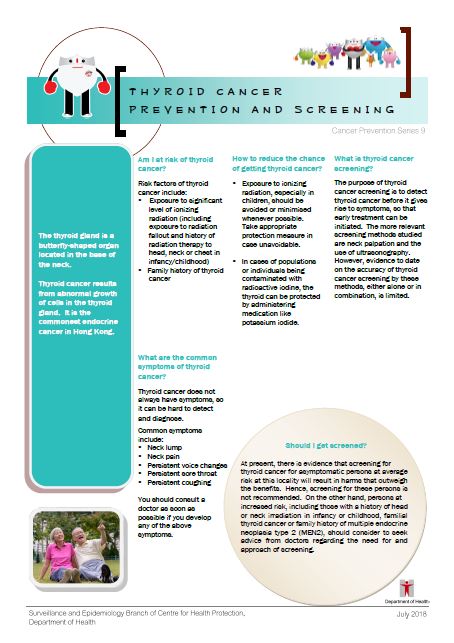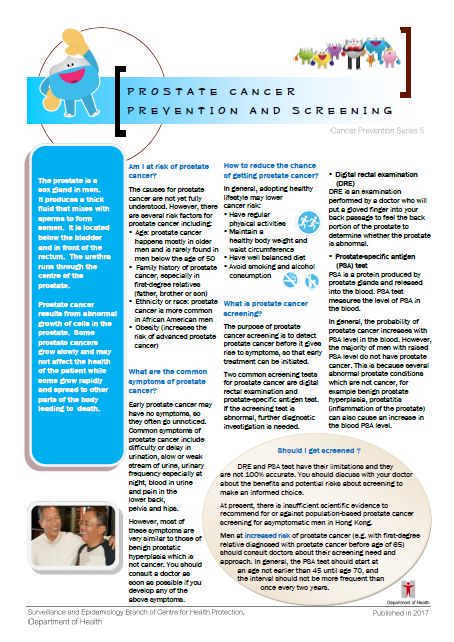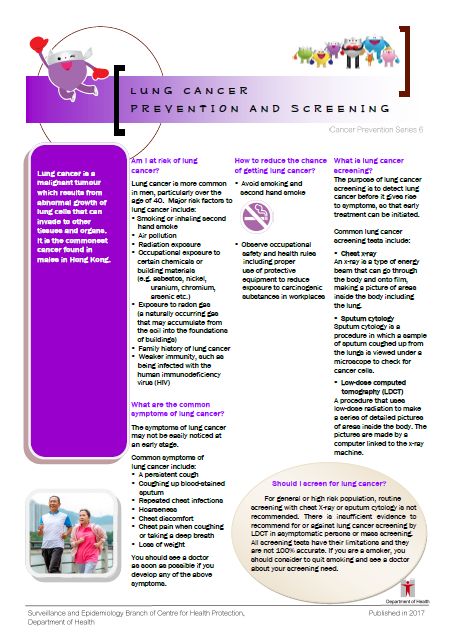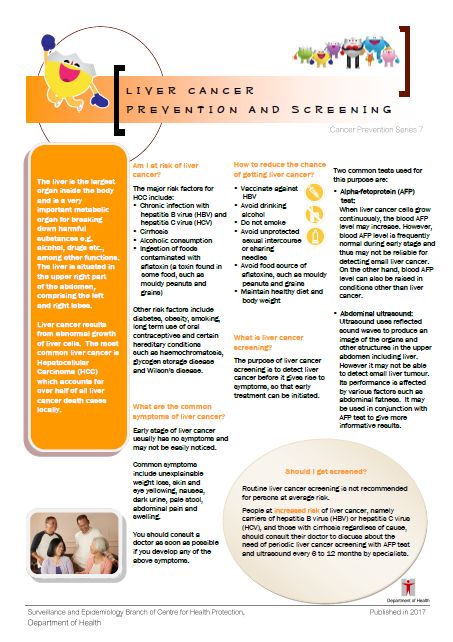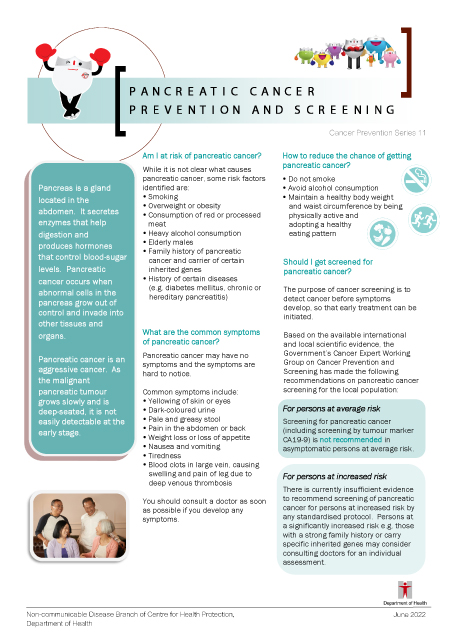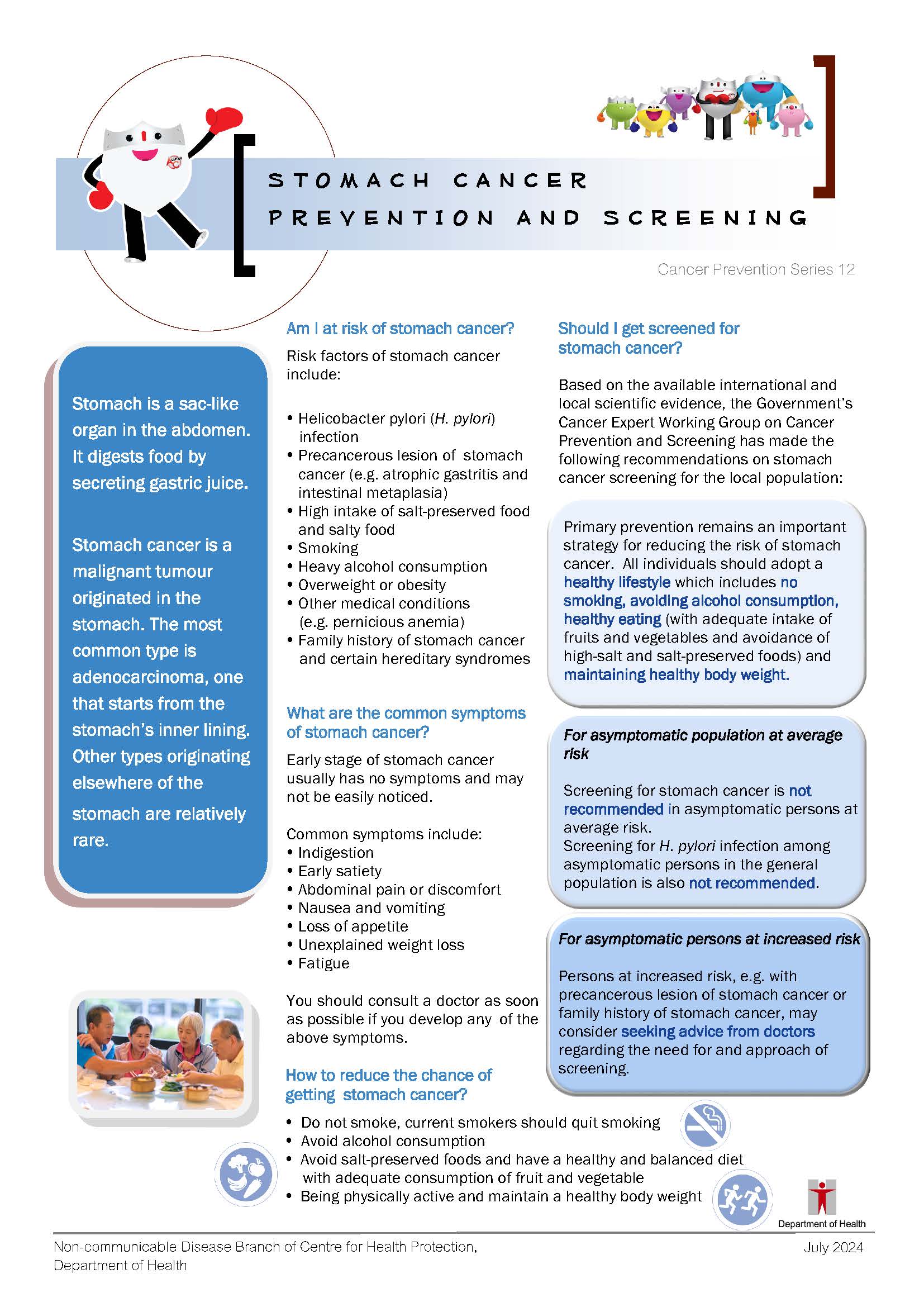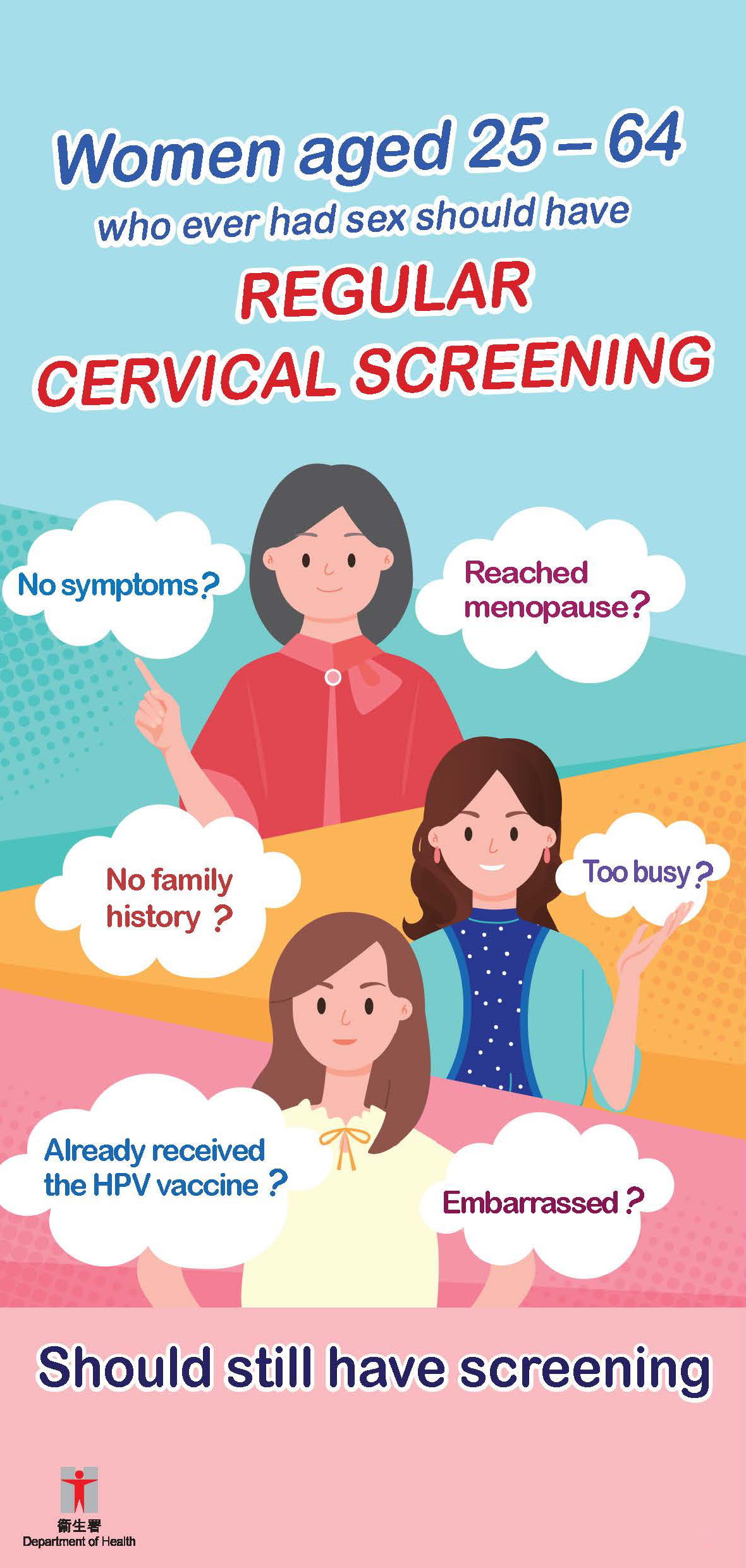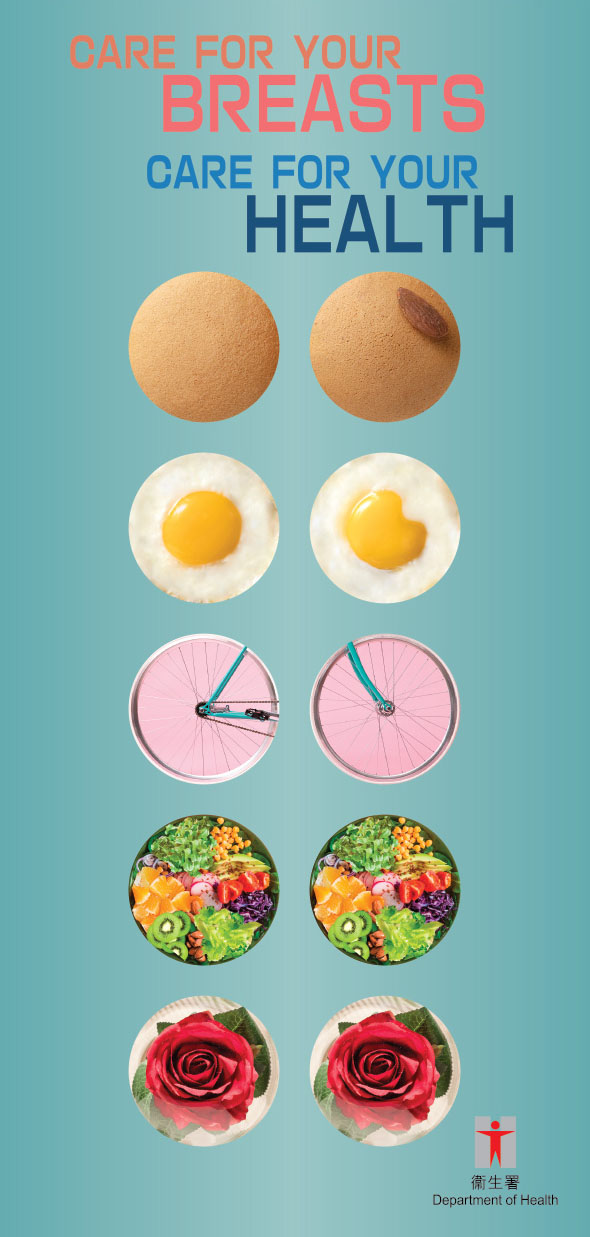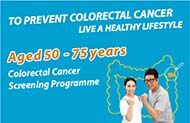Prevention and Screening
Risk Factors
Smoking
Tobacco smoke releases more than 7 000 chemicals including tar, nicotine, carbon monoxide which are known to cause great harm to human body. Tobacco smoking is a Group 1 carcinogen classified by the International Agency for Research on Cancer. Smokers have a higher risk of a variety of cancer types, such as lung, oesophagus, larynx, oral cavity, bladder, kidney, stomach, cervix and colorectum. Apart from cancer, smokers also have an increased risk for heart diseases and cerebrovascular disease.
Environmental tobacco smoke (second hand smoke) also increases the risk for lung cancer, heart diseases and respiratory symptoms.
Use of e-cigarette is also harmful to the body. There is now conclusive evidence that, in addition to nicotine, most e-cigarette products contain and emit numerous potentially toxic substances which are harmful to health. Long-term use of e-cigarette is expected to increase the risk of cancers and various heart and lung diseases, as well as some other diseases associated with smoking.
Alcohol consumption
Alcohol has both immediate and long-term effects on health. Drinking alcohol in large amount in a short period of time can lead to acute harm due to accident or violence to oneself and others. It also increases the risk of intoxication, even death.
In terms of cancer risk, there is no safe level of drinking. Alcohol is a Group 1 carcinogen classified by the International Agency for Research on Cancer. Risk of cancer increases with the amount of alcohol consumed. The more alcohol consumed and cumulated over time, the higher the chance of suffering from a wide range of long term illnesses such as cancers of oral, pharynx, larynx, oesophagus, liver, colorectum and female breasts, and other diseases such as gastritis, gastric ulcers, liver cirrhosis, obesity, heart disease, stroke and mental and behavioral disorders.
Unhealthy diet
Unhealthy diet, such as high intake of saturated fatty acids, high intake of total fat and inadequate consumption of dietary fibre, may lead to obesity or specific nutrient deficiency. These in turn may increase the risk of a variety of health problems, including cancers, heart diseases, cerebrovascular diseases, diabetes mellitus and hypertension.
In particular, high consumption of red meat, especially processed meat, is associated with risk of colorectal cancer which is the commonest cancer in the recent few years in Hong Kong.
Intake of nitrosamines in preserved food like salted fish has been shown to associate with nasopharyngeal cancer (“NPC”) which is more prevalent in the southern part of China including Hong Kong.
Lack of physical activity
Lack of physical activity is one of the major risk factors for non-communicable diseases (NCDs), such as cancers, heart diseases, cerebrovascular disease, diabetes mellitus, and hypertension. It is also a major contributor to the rise in the rates of overweight and obesity in many parts of the world. Some researchers suggest that it independently increases the risk of more than ten cancers like liver, prostate, colorectal, breast and uterine cancers.
Overweight and obesity
The Body Mass Index (“BMI”) is one of the methods for measuring overweight and obesity. It is calculated by dividing the body weight (in kg) by the square of height (in m): kg/m². For Chinese adults living in Hong Kong, BMI from 23.0 to less than 25.0 kg/m² is classified as overweight and BMI 25.0 kg/m² or above is classified as obese. For most Asian adults including Chinese, central obesity is defined as waist circumference > 90 cm for men and > 80 cm for women.
Obesity increases the risk for some types of cancer including breast, prostate, colorectal and endometrial cancers and other chronic diseases, such as hypertension, heart diseases, hypercholesterolaemia, diabetes mellitus, cerebrovascular disease, gallbladder disease, osteoarthritis and sleep apnoea.
Chronic infection by some cancer-causing viruses
Chronic hepatitis B virus infection
Hepatitis B virus (HBV) virus can cause acute hepatitis. Approximately 5-10% of adults and 95% of perinatally infected infants are unable to clear the virus, thus becoming chronic carriers. They may subsequently develop chronic hepatitis, permanent liver damage or liver cancer.
Chronic HBV infection (also called chronic hepatitis) is a major cause of liver cancer in Hong Kong, accounting for about 80% of liver cancer in the locality. HBV infections also interact with exposure to aflatoxin (through consumption of contaminated food) in increasing the risk of liver cancer.
Human papillomavirus infection
Human papillomavirus (“HPV”) is a group of viruses that includes more than 150 types. Around 40 of these viruses infect the genital area of men and women. HPV infection is usually found in persons who have ever been sexually active.
HPV is the world’s commonest sexually transmitted viral infection of the reproductive tract, which can cause premalignant changes and malignant cancers of cervix, vagina, vulva and anus. Almost all cervical cancers are caused by persistent infection with one of the cancer-causing (or high-risk) HPV types.
Apart from cancers of the reproductive tract, HPV can also causes cancers of the oral cavity, oropharynx, etc.
Excessive exposure to Ultraviolet radiation
The principal source of Ultraviolet (“UV”) exposure for most people is the sun. Other sources include sun lamps or tanning beds.
A moderate exposure to the sunlight helps our body to produce vitamin D, which is important for maintaining healthy bones. However, excessive exposure to UV radiation is known to cause increased risk of skin cancers and cataracts, premature ageing of the skin, painful sunburn and wrinkling.
Environmental pollution and occupational exposure to carcinogenic chemicals
Environmental pollution of air, water and soil with carcinogenic chemicals accounts for 1% to 4% of all cancers. Exposure to carcinogenic chemicals in the environment can occur through drinking water or pollution of indoor and ambient air. Exposure to outdoor air pollution in general, and specifically to particulate matter, causes lung cancer and diesel engine emission is still widespread in different parts of the world.
Occupational cancers are concentrated among specific groups of the working population who are exposed to several well‐recognised carcinogens such as asbestos, polycyclic aromatic hydrocarbons and heavy metals.
Tips to Prevent Cancers
Avoid smoking and second hand smoke
Members of the public are reminded not to use any tobacco products and smokers are encouraged to quit smoking. The risk of suffering from smoking-related diseases, e.g. lung cancer, respiratory diseases, heart diseases and stroke, can be reduced. Also, family members can be protected against the harm of second hand smoke.
For more information, please visit the Department of Health Tobacco and Alcohol Control Office “Tobacco Control” website.
Avoid alcohol consumption
As it is evident that alcohol produces more harm than potential health benefit, non-drinkers should not start drinking for the perceived health benefits of alcohol consumption. For those who choose to drink alcoholic beverages, limit the drink to minimise alcohol-related harm. Children and pregnant women should not drink at all. Also, one should avoid alcohol before driving, operating machine, handling dangerous goods or vigorous exercise, and when taking medication.
For more information, please visit the Department of Health “Change for Health – Alcohol and Health” website.
Have a balanced diet
Ensuring an adequate intake of fruit and vegetables should further reduce risk for a variety of cancer types such as oral cavity, oesophagus, stomach and colorectum.
Adequate amount of fruit and vegetable intake is an essential component of healthy eating. WHO recommends a daily intake of at least 400 grams of fruit and vegetables (about 5 servings of fruit and vegetables) for the prevention of chronic diseases such as heart diseases, hypertension, cerebrovascular diseases, diabetes and certain cancers.
Having a balanced diet and reduction of consumption of red and processed meat could reduce the risk of colorectal cancer, and the avoidance on consumption of foods containing nitrosamines helps reduce the risk of nasopharyngeal cancer (“NPC”).
For more information, please visit Department of Health “Change for Health – Healthy Diet” and “EatSmart” website.
Be physically active
Regular physical activity improves cardio-pulmonary function and reduces the risk of developing many chronic diseases. It helps to maintain an optimum body weight and healthy bones, muscles and joints. Moreover, it helps to decrease bone loss and prevent osteoporosis in menopausal women. It also reduces stress, depression and anxiety and promotes psychological well-being.
According to WHO recommendations,
- All healthy children and youth aged 5-17 years without any contraindication to physical activity should accumulate at least 60 minutes of moderate- to vigorous-intensity physical activity every day.
- All healthy adults and elders without any contraindication to physical activity should do at least 150 minutes a week of moderate-intensity aerobic physical activity, or at least 75 minutes a week of vigorous-intensity aerobic physical activity, or an equivalent combination of moderate- and vigorous-intensity activity.
For more information, please visit Department of Health “Change for Health – Physical Activity” website.
Maintain a healthy body weight and waist circumference
For optimal health, Chinese men in Hong Kong should keep their waist circumference below 90 cm and women should keep theirs below 80 cm irrespective of their BMI. To achieve these, members of the public are advised be proactive in decreasing sugar consumption. A balanced diet and regular physical activity are the proven ways to achieve and maintain an ideal body weight.
For more information, please visit the Department of Health “Change for Health – Halt the Rise in Diabetes and Obesity” website.
Get vaccinated against hepatitis B virus and human papillomavirus virus
Hepatitis B vaccination
An effective vaccine against hepatitis B infection is available. Universal vaccination with the hepatitis B vaccination has been part of the Hong Kong Childhood Immunisation Programme (“HKCIP”) since 1988. The standard vaccination scheme is a 3-dose schedule administered at 0, 1, 6 months. Adhering to the vaccination schedule is important to prevent hepatitis B infection and liver cancer.
To learn more, please visit the Department of Health Viral Hepatitis Control Office “Hepatitis B Vaccine” website.
Human papillomavirus vaccination
Human papillomavirus (“HPV”) vaccination has been shown to provide protection against HPV infections. HPV vaccines are prescription-only medicines, women are advised to consult registered doctors for vaccination.
The Government has allocated resources to expand the HKCIP to cover vaccination against HPV. Eligible female primary school students of suitable ages are provided with HPV vaccination to prevent cervical cancer since the 2019/20 school year.
For more information, please visit the “Human Papillomavirus Vaccination” and “Child Health - Immunisation” website of the Centre for Health Protection and the Family Health Service, Department of Health, respectively.
Protect against excessive UV exposure
To reduce the harm from UV radiation, the most important thing is to minimise direct exposure of the skin to sunlight. Also, public should avoid the use of sun lamps or tanning beds. One should seek medical advice as soon as possible for any suspicious changes in existing moles.
For more information, please visit the Department of Health “Ultraviolet Radiation and Health” website.
Minimise environmental and occupational exposure to carcinogenic chemicals
To reduce the chance of getting lung cancer, the single most important prevention strategy is to avoid smoking and second hand smoke. Members of the public are reminded not to use any tobacco products and smokers are encouraged to quit smoking.
It is important to observe the relevant Ordinances such as Occupational Safety and Health Ordinance (Cap. 509) and Air Pollution Control Ordinance (Cap. 311) to reduce exposure to carcinogenic substances in workplaces and daily environment.
For more information, please visit the Labour Department “Occupational Safety and Health” website and Environmental Protection Department “Air Pollution Control Ordinance” website.
Practice safer sex
Some cancer-causing infections such as hepatitis B virus and human papillomavirus can be transmitted through sexual contact. Use of condom and avoiding high risk sexual activity (such as having multiple sexual partners) can help to reduce the risk of getting cancers-causing infection contracted through sexual contact.
For more information, please visit the “Prevention of Hepatitis” website of Viral Hepatitis Control Office, Department of Health and Leaflet on “Cervical Cancer Prevention and Screening”.
Cancer Screening
What is screening?
Screening means examining people without symptoms in order to detect disease or identify people at increased risk of disease. It is often the first step in making a definitive diagnosis.
The Government has launched two screening programmes currently, namely the Cervical Screening Programme (CSP) and the Colorectal Cancer Screening Programme (CRCSP).
Cervical Screening Programme
The Government promotes cervical screening in collaboration with the healthcare sector to facilitate and encourage women to have regular cervical screening to prevent cervical cancer.
To facilitate sharing of information among healthcare providers, the Cervical Screening Information System (www.csis.gov.hk) has been established. It is a computerised registry for keeping and processing related data, including participants’ personal information, screening results and next recommended screening date.
For more details, please visit the website of Cervical Screening Programme.
Colorectal Cancer Screening Programme
The Colorectal Cancer Screening Programme (CRCSP) was launched, as a pilot programme initially in September 2016 and regularised in August 2018, by using a public‐private partnership model to subsidise asymptomatic Hong Kong residents aged between 50 and 75 in phases to undergo screening tests to prevent colorectal cancer, the commonest cancer in Hong Kong.
For more details, please visit the website of Colorectal Cancer Screening Programme. 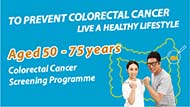
Breast Cancer Screening Pilot Programme Phase II for women at high risk
Breast Cancer Screening Pilot Programme Phase II (BCSPP II) was launched on 10 June 2025 to provide subsidised screening services through public-private partnership programmes in collaboration with non-governmental organisations (NGOs) to female Hong Kong residents aged 35 to 74 who are at high risk of developing breast cancer, i.e. carriers of certain gene mutation(s) or with a strong family history of breast cancer/ovarian cancer, with a view to enhancing the recovery rate of breast cancer patients through early detection and treatment.
For details, please visit the website of Breast Cancer Screening Pilot Programme Phase II.
Resources
Pamphlets
If the above health education materials (except marked with asterisk) are needed, please make your request by clicking the hyperlink:
